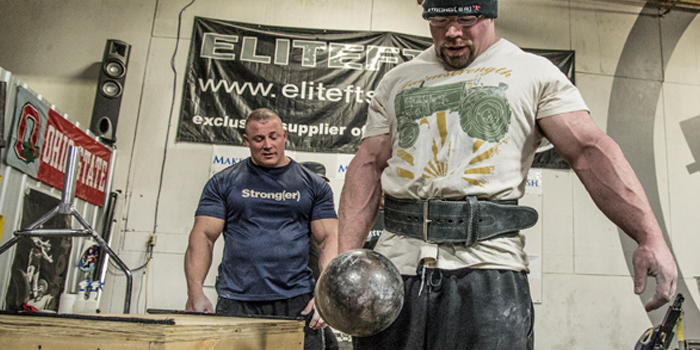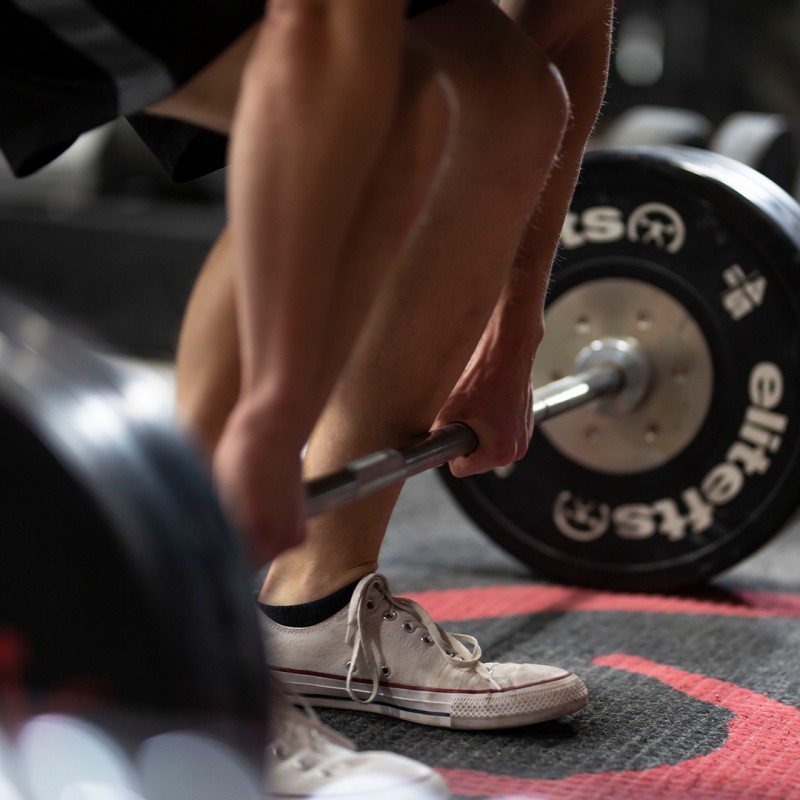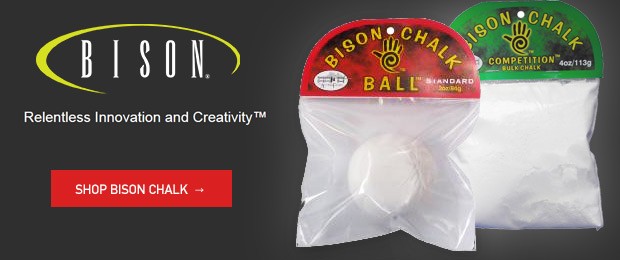
As any powerlifter will tell you, the world revolves around us: our training schedules, our eating schedules, our nap schedules, our meet schedules, bathroom breaks, and water intake routines. Not a single thing in the world can not be somehow related back to powerlifting.
Shopping bags? I got this. One trip baby.
Opening doors? Step aside. I bench hundreds of pounds. Watch and learn how to enter a room chest first like a living, breathing (gasping) Johnny Bravo.
Need something hoisted? No problem! Just let me grab my knee wraps.
Life, ab initio, is a powerlifting accessory. Something fewer people know, however, is there is an entire organization dedicated to deadlift/grip accessories: The North American Grip Sport Organization (NAGSO). While we as lifters may not have the firmest grip on the actuality of our own self-importance, we certainly want to make sure our oft sore and bleeding palms don’t pull an old Jack-and-Rose a la Titanic on us and just let go, no matter how much they promised they never would.
The following is a review of grip sport competition events as well as a general overview of the rules, should you decide to take grip training further than merely ensuring you don’t bomb out of a meet in a manner so devastating as waiting for your ninth attempt to do it.
MORE: 5 Deadlift Cues with Ed Coan
The NAGSO website (gripsport.org) describes eleven different events: grippers, choked grippers, axle deadlift, two hand pinch, weaver stick, supported sledge lever, vertical bar lift, medley, timed wrist roller pull for distance, sledgehammer choke, and pinch block curl. I’ve only before heard of one of them (axle deadlift). The rules are, you must complete the event according to the rules and you can only use chalk. No straps, no hook grip. Further, most events are allowed a fourth attempt so grip athletes should plan for this in attempt selection. If an athlete begins an attempt before the cue of the judge, he or she does not lose the attempt, they just have to do it again—but honestly, I don’t know what’s worse. You also can’t have your mom or boyfriend judge you, we all know significant others, in particular, are biased toward grip strength.
Scoring is bonkers. I don’t even know how to describe it other than there are points and it’s graded on a curve. The website reads, “The scoring system used in U.S. Grip sanctioned contests is percentage-based scoring. The best performance in the event is awarded 100 points. All other lifters’ performances are divided by the best performance and then multiplied by 100 for their score.” Whatever that means. They also give an example but that only further muddied my powerlifting brain that can only efficiently count by 45 and divide by 2.2 (barely). From what I gather, if you want to win a grip sport competition, do better than everyone else.

On to the events. I tried to rank them in order of most likely to help you not blow your entire meet on dropped deadlifts to least likely, but they all seem truly terrible to me, a woman who does not do a single pull accessory outside barbell deadlifts themselves without lifting straps (no, I’ve never dropped a deadlift and pull comfortably into the 500s so keep the comments), so hang on everybody, we’re just diving in.
Grippers (parallel or 20mm block set)
I know it’s early to say this but so far my personal favorite. This is essentially competitive stress relief. The “equipment” looks like a wire barbell collar. The technique? Squeeze it. Hard. When the handles touch it’s a good “lift.” These can also be done on devices that are measured by “Gripper Rating Devices” set in chokers. There are more nuanced rules to this event but the gist of it is to squeeze the hell out of it, hopefully significantly better than the next guy squeezes his. You can practice this anywhere you have access to your own hand.
Axle Deadlift
This is a more traditional event, variations of which are seen in strongman contests, but it requires slightly more technique and equipment. The catch? Axle deadlifts must be held double overhand and with no hook grip. I’m not sure what mega-yeti out there has the finger-span to hook grip an axle bar, but it’s in the rules in case. The difference between grip sport axle and strongman axle is you can’t cheat. It’s double overhand, no straps, and you can’t rest the axle on your thighs before receiving the “down” command. Should you cave to any of these temptations, you guessed it, do it again. This event is similar more to the powerlifting deadlift in practice than the strongman event, but with a truly disadvantageously-sized bar.
Two Hand Pinch
Also called the Euro Pinch or the Napalm Pinch
Picture a dumbbell but instead of round bits on the sides, they are brick-shaped and smooth. Now from the dumbbell handle in the middle, there is a plate loading contraption that dangles between. The two hand pinch event consists of grabbing the “dumbbell” by the flat, smooth, brick-shaped metal bits (one hand per) and lifting it to a predetermined height off the floor. You don’t wrap your hands all the way around each “brick,” you pinch them from above on the smooth long sides. Two hand pinch is a rising bar event, so each attempt will require a further raise off the floor. I watched a YouTube video of a man Napalm Pinching 303 pounds and it made my fingertips burn from my living room couch. This seems like a lot of finger strength and less overall grip strength that could carry over to sucking less at deadlifts. Save it for the end of your training so, much like the ab wheel, you’ll feel less bad about ignoring it altogether.
Weaver Stick
This lift has some pros and cons. Pro: you get to wield a sword-shaped object. Con: It’s heavier on the end opposite the handle. It reminds me of those stick contraptions people have been swinging around themselves for shoulder mobility on Instagram lately. Pro: It builds immense forearm and wrist strength. Con: that’s pretty useless unless you’re playing weaver sticks. Follow up con: grip athletes don’t love when you call it “playing weaver sticks.”
The weaver stick is a rod of a particular length with a handle at one end that can be weight loaded on the other. The grip athlete must, by holding the handled end, lift the weighted end to a predetermined height off the surface. This is completed either facing the stick or facing away from the stick. A successful lift is called when the weaver stick is parallel to the floor. Grip athletes may lean their bodies into the lift, but no rocking and your arm and hand must remain free of your body (unless it’s an accident, which the judge who can not be your mom or girlfriend gets to decide).
Medley
Remember when you were a kid and would take household items and create obstacle courses and race your friends? So that, but with grip sport implements. The official setup for medley is, “Various implements/challenges are situated around the competition area. The athlete tries to complete as many of the implements/challenges as possible within the time limit,” according to the NAGSO website. This is great for both adults who like to be better than their friends at multiple things at once, as well as children who are incentivized to do pretty much anything on the planet with the promise of, “I’ll time you!” Also, if you pick a variety of events not including the weaver stick it’s probably a pretty good way to train your grip strength with variety and spice.
Timed Wrist Roller Pull For Distance
What is there to say about this one the name doesn’t explicate for itself? Imagine you have a kite, but it’s made of weights, and you put the kite on the ground all the way over there. Now you unwind the string as far as it will go walking away from said iron kite. Turn, face the kite, hold the handle with two hands and twist as rapidly as you possibly can, winding the string around the handle and pulling the iron kite toward you, of course, better than anyone else. This also seems to be geared more toward the forearm dominant grip athlete as opposed to the finger strength grip athlete. But for the right kind of rapid wrist rolling adult who perhaps grew up in the right kind of kite flying, reeless fishing rod atmosphere, this event is an opportunity for domination. Final note: thumbless grip is allowed in the timed wrist roller pull for distance.
Sledgehammer Choke
This event is quite similar to the Weaver Stick, except less cool because it’s just a sledgehammer and not a full on sword pole. I feel it appropriate to take a moment to marvel at the simplicity of this event. There are three manageable steps to successfully completing this challenge.
- Get a sledgehammer
- Put a quarter on it
- Pick it up
That’s the event. Sure, there are nuances like not letting the quarter fall, not bumping the sledgehammer head into the platform on which you are to place it for completion, and keeping your hand behind the increment line on the sledgehammer handle. But for all intents and purposes, it’s an all grownup, manly man, beard oiled, shot-and-a-beer, rough and rowdy egg-on-a-spoon game. Deadlift carryover rating: 3/10. Nostalgia rating: 10/10.
Pinch Block Curl
This is the grip sport version of the Strict Curl event you’ll see at some old powerlifting competitions. It’s a relic of the past, as I haven’t seen it since I did my first couple hyper local NASA powerlifting meets four years and 30 pounds of bodyweight ago, but in grip sport, it’s still alive and kicking with a masochistic twist. Instead of using a nice comfortable curl bar to bring through the range of motion, you must use an implement that looks like a medieval torture device, banned from every other strength sport platform finding refuge under the protective arm of the NAGSO. It’s an inside out dumbbell. Where the weight plates would be are handles, and where the handle should be are weight plates. A simpler way to describe this is it looks much like another piece of accessory equipment I love to ignore: the ab wheel. Should have led with that. Oh, and it’s iron. Oh, and one of the handles is flat like a smooshed brick. That’s the side you have to hold in a pinch grip while completing a curl.
The lift is to be started with the athletes shoulders, back and butt against the wall (funny enough, this is my instinctual position when anyone approaches me about curls), and these three points of contact must be maintained throughout the event. In watching videos on YouTube, it seems the grip athletes tend to grip the block with the inside of their thumbs as opposed to the pads of the digit. It looks very similar to (whisper now) a deconstructed hook grip the way the thumb lays flat across the surface as a hooker would place it across a barbell.
This concludes our overview of the 11 grip strength events as put forth by the North American Grip Sport Organization. For more information on divisions, top 100 lists, event-specific rules, and an extremely outdated events calendar, head over to their website, www.nagso.org.
All jokes aside, grip training is a great way to improve your deadlift overall and add variety, fun, and a new aspect of competition to training. I’m no professional, but I guarantee if you master these events you’ll never disappoint your mom, dad, siblings, loved ones, friends, and coach all at the same time by dropping a deadlift on the platform again.
Emma Jarman is a Cleveland, Ohio-based mother of one, amateur baker and writer. In her downtime, she works full time in marketing. Emma’s athletic background is in swimming and running with a short stint as a figure competitor. She entered the powerlifting community in 2015 and has since earned multiple pro totals and a top 10 ranking in the 181-pound weight class.











I’d say that your rankings are pretty much spot on, except I would put spring grippers much farther down. I don’t know if it’s the steep strength curve or the dynamic range of motion, but it’s pretty much accepted as fact in the grip community that gripper strength doesn’t transfer to general grip strength and vice versa.
Axle deadlifts are great but could add some technique interference to the competitive deadlift. One-hand rolling handles are something worth looking into: less range of motion, less weight, less fatigue. They could be added in without taking away from the rest of one’s training.
One overlooked aspect of deadlift grip, particularly mixed grip, is that the thumb squeezes the fingers and increases the friction between them. Pinching is great for thumb strength.
Like you mentioned, the NAGS website is very outdated. I’ve never seen some of those events contested in a grip contest. If interested, grip contests are currently announced on a forum called GripBoard and also ArmliftingUSA.
Thanks for the article, Emma.